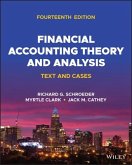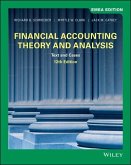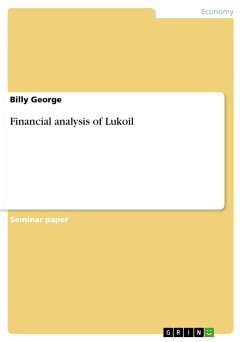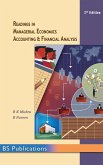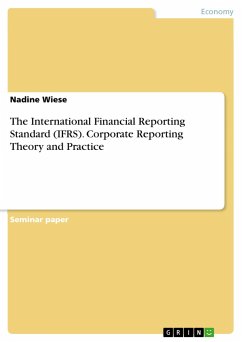Richard G. Schroeder (Texas A & M University), Myrtle W. Clark (University of Kentucky), Jack M. Cathey (University of North Carolina at Charlotte)
Financial Accounting Theory and Analysis
Text and Cases, 50th Anniversary
Richard G. Schroeder (Texas A & M University), Myrtle W. Clark (University of Kentucky), Jack M. Cathey (University of North Carolina at Charlotte)
Financial Accounting Theory and Analysis
Text and Cases, 50th Anniversary
- Broschiertes Buch
- Merkliste
- Auf die Merkliste
- Bewerten Bewerten
- Teilen
- Produkt teilen
- Produkterinnerung
- Produkterinnerung
Master Financial Accounting Theory, Standards, and Applications with Expert Insights and Case Studies Understanding the theoretical foundations of financial accounting is crucial for navigating today's complex and evolving financial landscape. In the fifteenth edition of Financial Accounting Theory and Analysis: Text and Cases, a team of distinguished accounting scholars explores how accounting standards shape financial reporting choices and analyzes the characteristics of firms based on their accounting methods. With comprehensive discussions on key frameworks and professional standards,…mehr
Andere Kunden interessierten sich auch für
![Financial Accounting Theory and Analysis Financial Accounting Theory and Analysis]() Richard G SchroederFinancial Accounting Theory and Analysis139,99 €
Richard G SchroederFinancial Accounting Theory and Analysis139,99 €![Financial Accounting Theory and Analysis Financial Accounting Theory and Analysis]() Richard G. SchroederFinancial Accounting Theory and Analysis73,99 €
Richard G. SchroederFinancial Accounting Theory and Analysis73,99 €![Financial analysis of Lukoil Financial analysis of Lukoil]() Billy GeorgeFinancial analysis of Lukoil18,95 €
Billy GeorgeFinancial analysis of Lukoil18,95 €![Readings in Managerial Economics, Accounting and Financial Analysis Readings in Managerial Economics, Accounting and Financial Analysis]() R K MishraReadings in Managerial Economics, Accounting and Financial Analysis70,99 €
R K MishraReadings in Managerial Economics, Accounting and Financial Analysis70,99 €![The International Financial Reporting Standard (IFRS). Corporate Reporting Theory and Practice The International Financial Reporting Standard (IFRS). Corporate Reporting Theory and Practice]() Nadine WieseThe International Financial Reporting Standard (IFRS). Corporate Reporting Theory and Practice17,95 €
Nadine WieseThe International Financial Reporting Standard (IFRS). Corporate Reporting Theory and Practice17,95 €![Analysis of Financial Statements Analysis of Financial Statements]() Richard P. WilsonAnalysis of Financial Statements26,99 €
Richard P. WilsonAnalysis of Financial Statements26,99 €![Managerial Economics and Financial Analysis Managerial Economics and Financial Analysis]() Maddali AravindManagerial Economics and Financial Analysis51,99 €
Maddali AravindManagerial Economics and Financial Analysis51,99 €-
-
-
Master Financial Accounting Theory, Standards, and Applications with Expert Insights and Case Studies Understanding the theoretical foundations of financial accounting is crucial for navigating today's complex and evolving financial landscape. In the fifteenth edition of Financial Accounting Theory and Analysis: Text and Cases, a team of distinguished accounting scholars explores how accounting standards shape financial reporting choices and analyzes the characteristics of firms based on their accounting methods. With comprehensive discussions on key frameworks and professional standards, students gain a deep understanding of the principles guiding accounting practice. Through a combination of rigorous theoretical analysis, empirical research, and real-world case studies, this leading textbook strengthens students' critical thinking and decision-making skills while providing future professionals with the analytical and ethical foundation needed to succeed in today's global financial environment. Providing essential knowledge for careers in financial reporting, auditing, and corporate finance, Financial Accounting Theory and Analysis: Text and Cases is ideal for senior undergraduate and graduate courses in Financial Accounting Theory, Advanced Financial Accounting, and Accounting Research.
Produktdetails
- Produktdetails
- Verlag: John Wiley & Sons Inc
- 15 ed
- Seitenzahl: 768
- Erscheinungstermin: 20. Oktober 2025
- Englisch
- Abmessung: 203mm x 256mm x 32mm
- Gewicht: 1416g
- ISBN-13: 9781394336531
- ISBN-10: 1394336535
- Artikelnr.: 74978613
- Herstellerkennzeichnung
- Libri GmbH
- Europaallee 1
- 36244 Bad Hersfeld
- gpsr@libri.de
- Verlag: John Wiley & Sons Inc
- 15 ed
- Seitenzahl: 768
- Erscheinungstermin: 20. Oktober 2025
- Englisch
- Abmessung: 203mm x 256mm x 32mm
- Gewicht: 1416g
- ISBN-13: 9781394336531
- ISBN-10: 1394336535
- Artikelnr.: 74978613
- Herstellerkennzeichnung
- Libri GmbH
- Europaallee 1
- 36244 Bad Hersfeld
- gpsr@libri.de
Preface
xi 1 The Development of Accounting Theory
1 The Early History of Accounting
2 Accounting in the United States Since 1930
5 The Role of Ethics in Accounting
21 International Accounting Standards
25 2 The Pursuit of the Conceptual Framework
30 The Early Theorists
30 Professional Organizations' and Authoritative Standard-Setting Bodies' Contributions
32 Committee on Accounting Procedure
33 Accounting Principles Board
33 A Statement of Basic Accounting Theory
36 The Trueblood Committee
37 Statement on Accounting Theory and Theory Acceptance
39 The FASB's Original Conceptual Framework Project
42 International Cooperation
44 Principles-Based Versus Rules-Based Accounting Standards
61 International Convergence
65 3 International Accounting
78 International Business Accounting Issues
79 he Development of Accounting Systems
79 Preparation of Financial Statements for Foreign Users
81 The International Accounting Standards Committee
81 The Uses of International Accounting Standards
93 The IASC and the IOSCO
94 The IASB Annual Improvements Project
96 IASB-FASB Convergence
96 The Effects of International Versus US GAAP Accounting Standards
97 Standards Overload
100 Framework for the Preparation and Presentation of Financial Statements
102 The IASB-FASB Financial Statement Presentation Project
111 4 The Status
Development and Uses of Financial Reporting
119 The Financial Reporting Environment
119 Research Methodology
122 The Outcomes of Providing Accounting Information
125 The Relationship Among Accounting Research
Education
and Practice
155 5 Income Concepts
Revenue Recognition
and Other Methods of Reporting
162 The Nature of Income
163 Economic Versus Accounting Income
167 Revenue Recognition
169 Matching
188 Income Recognition Constraints
190 Non-GAAP Measures of Performance
192 Sustainability Reporting
194 Earnings Quality
Earnings Management
and Fraudulent Financial Reporting
205 International Accounting Standards
211 6 Financial Statement I: The Income Statement
227 The Economic Consequences of Financial Reporting
227 Income Statement Elements
227 Statement Format
229 The Value of Corporate Earnings
254 International Accounting Standards
259 7 Financial Statements II: The Balance Sheet and the Statement of Cash Flows
273 The Balance Sheet
274 Fair Value Measurements
285 Evaluating a Company's Financial Position
292 The Statement of Cash Flows
295 Financial Analysis of Cash-Flow Information
306 International Accounting Standards
307 8 Working Capital
321 Development of the Working Capital Concept
321 Current Usage
323 Components of Working Capital
323 Working Capital Management
335 International Accounting Standards
343 9 Long-Term Assets I: Property
Plant
and Equipment
350 Property
Plant
and Equipment
350 Financial Analysis of Property
Plant
and Equipment
355 Cost Allocation
355 Capital and Revenue Expenditures
359 Recognition and Measurement Issues
359 Impairment of Value
360 Accounting for Asset Retirement Obligations
362 International Accounting Standards
365 10 Long-Term Assets II: Investments and Intangibles
377 Investments in Equity Securities
377 Investments in Debt Securities
386 Impairment of Investments in Unsecuritized Debt Including Receivables and Loans
390 The Fair Value Option for Financial Assets
394 Transfers of Financial Assets
395 Intangibles
396 Financial Analysis of Investments and Intangibles
414 International Accounting Standards
414 11 Long-Term Liabilities
432 The Definition of Liabilities
432 Recognition and Measurement of Liabilities
433 Debt versus Equity
434 Classification of Long-Term Debt
437 Other Liability Measurement Issues
452 Reference Rate Reform
460 Troubled Debt Restructurings
461 Financial Analysis of Long-Term Debt
464 International Accounting Standards
466 12 Accounting for Income Taxes
481 Historical Perspective
481 The Income Tax Allocation Issue
483 Permanent and Temporary Differences
483 Conceptual Issues
487 Alternative Interperiod Tax Allocation Methods
491 Financial Statement Disclosure
500 FIN No. 48
"Accounting for Uncertainty in Income Taxes - An Interpretation of FASB Statement No. 109"
504 The Tax Cuts and Jobs Act of 2017
505 Financial Analysis of Income Taxes
508 International Accounting Standards
511 13 Leases
519 Accounting for Leases
520 Historical Perspective
521 Subsequent Developments
532 FASB ASC 842
534 Lease Agreements Affected by ASU 2020-04 Reference Rate Reform
545 Financial Analysis of the Effects of Capitalizing Operating Leases
547 International Accounting Standards
549 14 Pensions and Other Postretirement Benefits
561 Historical Perspective
563 Accounting for the Pension Fund
573 The Employee Retirement Income Security Act
574 Other Postretirement Benefits
575 Postemployment Benefits
577 SFAS No. 132
577 SFAS No. 158
577 ASU 2017-07
579 ASU 2018-14
580 Financial Analysis of Pension and Other Postretirement Benefits
581 International Accounting Standards
581 15 Equity
589 Theories of Equity
590 Definition of Equity
594 The Distinction Between Debt and Equity
595 Corporate Equity
598 Financial Analysis of Stockholders' Equity
611 International Accounting Standards
612 16 Accounting for Multiple Entities
621 Business Combinations
621 Accounting for Business Combinations
623 Consolidations
630 Financial Engineering and the Role of Structured Entities
634 Theories of Consolidation
637 Noncontrolling Interest
639 Drawbacks of Consolidation
641 Joint Ventures
642 Special Purpose Acquisition Companies
643 Segment Reporting
646 Foreign Currency Translation
653 International Accounting Standards
660 17 Financial Reporting Disclosure Requirements and Ethical Responsibilities
680 Recognition and Measurement Criteria
680 The Securities and Exchange Commission
703 Ethical Responsibilities
712 International Accounting Standards
721 Cases
727 FASB ASC Research
731 Room for Debate
732 Index
I-1
xi 1 The Development of Accounting Theory
1 The Early History of Accounting
2 Accounting in the United States Since 1930
5 The Role of Ethics in Accounting
21 International Accounting Standards
25 2 The Pursuit of the Conceptual Framework
30 The Early Theorists
30 Professional Organizations' and Authoritative Standard-Setting Bodies' Contributions
32 Committee on Accounting Procedure
33 Accounting Principles Board
33 A Statement of Basic Accounting Theory
36 The Trueblood Committee
37 Statement on Accounting Theory and Theory Acceptance
39 The FASB's Original Conceptual Framework Project
42 International Cooperation
44 Principles-Based Versus Rules-Based Accounting Standards
61 International Convergence
65 3 International Accounting
78 International Business Accounting Issues
79 he Development of Accounting Systems
79 Preparation of Financial Statements for Foreign Users
81 The International Accounting Standards Committee
81 The Uses of International Accounting Standards
93 The IASC and the IOSCO
94 The IASB Annual Improvements Project
96 IASB-FASB Convergence
96 The Effects of International Versus US GAAP Accounting Standards
97 Standards Overload
100 Framework for the Preparation and Presentation of Financial Statements
102 The IASB-FASB Financial Statement Presentation Project
111 4 The Status
Development and Uses of Financial Reporting
119 The Financial Reporting Environment
119 Research Methodology
122 The Outcomes of Providing Accounting Information
125 The Relationship Among Accounting Research
Education
and Practice
155 5 Income Concepts
Revenue Recognition
and Other Methods of Reporting
162 The Nature of Income
163 Economic Versus Accounting Income
167 Revenue Recognition
169 Matching
188 Income Recognition Constraints
190 Non-GAAP Measures of Performance
192 Sustainability Reporting
194 Earnings Quality
Earnings Management
and Fraudulent Financial Reporting
205 International Accounting Standards
211 6 Financial Statement I: The Income Statement
227 The Economic Consequences of Financial Reporting
227 Income Statement Elements
227 Statement Format
229 The Value of Corporate Earnings
254 International Accounting Standards
259 7 Financial Statements II: The Balance Sheet and the Statement of Cash Flows
273 The Balance Sheet
274 Fair Value Measurements
285 Evaluating a Company's Financial Position
292 The Statement of Cash Flows
295 Financial Analysis of Cash-Flow Information
306 International Accounting Standards
307 8 Working Capital
321 Development of the Working Capital Concept
321 Current Usage
323 Components of Working Capital
323 Working Capital Management
335 International Accounting Standards
343 9 Long-Term Assets I: Property
Plant
and Equipment
350 Property
Plant
and Equipment
350 Financial Analysis of Property
Plant
and Equipment
355 Cost Allocation
355 Capital and Revenue Expenditures
359 Recognition and Measurement Issues
359 Impairment of Value
360 Accounting for Asset Retirement Obligations
362 International Accounting Standards
365 10 Long-Term Assets II: Investments and Intangibles
377 Investments in Equity Securities
377 Investments in Debt Securities
386 Impairment of Investments in Unsecuritized Debt Including Receivables and Loans
390 The Fair Value Option for Financial Assets
394 Transfers of Financial Assets
395 Intangibles
396 Financial Analysis of Investments and Intangibles
414 International Accounting Standards
414 11 Long-Term Liabilities
432 The Definition of Liabilities
432 Recognition and Measurement of Liabilities
433 Debt versus Equity
434 Classification of Long-Term Debt
437 Other Liability Measurement Issues
452 Reference Rate Reform
460 Troubled Debt Restructurings
461 Financial Analysis of Long-Term Debt
464 International Accounting Standards
466 12 Accounting for Income Taxes
481 Historical Perspective
481 The Income Tax Allocation Issue
483 Permanent and Temporary Differences
483 Conceptual Issues
487 Alternative Interperiod Tax Allocation Methods
491 Financial Statement Disclosure
500 FIN No. 48
"Accounting for Uncertainty in Income Taxes - An Interpretation of FASB Statement No. 109"
504 The Tax Cuts and Jobs Act of 2017
505 Financial Analysis of Income Taxes
508 International Accounting Standards
511 13 Leases
519 Accounting for Leases
520 Historical Perspective
521 Subsequent Developments
532 FASB ASC 842
534 Lease Agreements Affected by ASU 2020-04 Reference Rate Reform
545 Financial Analysis of the Effects of Capitalizing Operating Leases
547 International Accounting Standards
549 14 Pensions and Other Postretirement Benefits
561 Historical Perspective
563 Accounting for the Pension Fund
573 The Employee Retirement Income Security Act
574 Other Postretirement Benefits
575 Postemployment Benefits
577 SFAS No. 132
577 SFAS No. 158
577 ASU 2017-07
579 ASU 2018-14
580 Financial Analysis of Pension and Other Postretirement Benefits
581 International Accounting Standards
581 15 Equity
589 Theories of Equity
590 Definition of Equity
594 The Distinction Between Debt and Equity
595 Corporate Equity
598 Financial Analysis of Stockholders' Equity
611 International Accounting Standards
612 16 Accounting for Multiple Entities
621 Business Combinations
621 Accounting for Business Combinations
623 Consolidations
630 Financial Engineering and the Role of Structured Entities
634 Theories of Consolidation
637 Noncontrolling Interest
639 Drawbacks of Consolidation
641 Joint Ventures
642 Special Purpose Acquisition Companies
643 Segment Reporting
646 Foreign Currency Translation
653 International Accounting Standards
660 17 Financial Reporting Disclosure Requirements and Ethical Responsibilities
680 Recognition and Measurement Criteria
680 The Securities and Exchange Commission
703 Ethical Responsibilities
712 International Accounting Standards
721 Cases
727 FASB ASC Research
731 Room for Debate
732 Index
I-1
Preface
xi 1 The Development of Accounting Theory
1 The Early History of Accounting
2 Accounting in the United States Since 1930
5 The Role of Ethics in Accounting
21 International Accounting Standards
25 2 The Pursuit of the Conceptual Framework
30 The Early Theorists
30 Professional Organizations' and Authoritative Standard-Setting Bodies' Contributions
32 Committee on Accounting Procedure
33 Accounting Principles Board
33 A Statement of Basic Accounting Theory
36 The Trueblood Committee
37 Statement on Accounting Theory and Theory Acceptance
39 The FASB's Original Conceptual Framework Project
42 International Cooperation
44 Principles-Based Versus Rules-Based Accounting Standards
61 International Convergence
65 3 International Accounting
78 International Business Accounting Issues
79 he Development of Accounting Systems
79 Preparation of Financial Statements for Foreign Users
81 The International Accounting Standards Committee
81 The Uses of International Accounting Standards
93 The IASC and the IOSCO
94 The IASB Annual Improvements Project
96 IASB-FASB Convergence
96 The Effects of International Versus US GAAP Accounting Standards
97 Standards Overload
100 Framework for the Preparation and Presentation of Financial Statements
102 The IASB-FASB Financial Statement Presentation Project
111 4 The Status
Development and Uses of Financial Reporting
119 The Financial Reporting Environment
119 Research Methodology
122 The Outcomes of Providing Accounting Information
125 The Relationship Among Accounting Research
Education
and Practice
155 5 Income Concepts
Revenue Recognition
and Other Methods of Reporting
162 The Nature of Income
163 Economic Versus Accounting Income
167 Revenue Recognition
169 Matching
188 Income Recognition Constraints
190 Non-GAAP Measures of Performance
192 Sustainability Reporting
194 Earnings Quality
Earnings Management
and Fraudulent Financial Reporting
205 International Accounting Standards
211 6 Financial Statement I: The Income Statement
227 The Economic Consequences of Financial Reporting
227 Income Statement Elements
227 Statement Format
229 The Value of Corporate Earnings
254 International Accounting Standards
259 7 Financial Statements II: The Balance Sheet and the Statement of Cash Flows
273 The Balance Sheet
274 Fair Value Measurements
285 Evaluating a Company's Financial Position
292 The Statement of Cash Flows
295 Financial Analysis of Cash-Flow Information
306 International Accounting Standards
307 8 Working Capital
321 Development of the Working Capital Concept
321 Current Usage
323 Components of Working Capital
323 Working Capital Management
335 International Accounting Standards
343 9 Long-Term Assets I: Property
Plant
and Equipment
350 Property
Plant
and Equipment
350 Financial Analysis of Property
Plant
and Equipment
355 Cost Allocation
355 Capital and Revenue Expenditures
359 Recognition and Measurement Issues
359 Impairment of Value
360 Accounting for Asset Retirement Obligations
362 International Accounting Standards
365 10 Long-Term Assets II: Investments and Intangibles
377 Investments in Equity Securities
377 Investments in Debt Securities
386 Impairment of Investments in Unsecuritized Debt Including Receivables and Loans
390 The Fair Value Option for Financial Assets
394 Transfers of Financial Assets
395 Intangibles
396 Financial Analysis of Investments and Intangibles
414 International Accounting Standards
414 11 Long-Term Liabilities
432 The Definition of Liabilities
432 Recognition and Measurement of Liabilities
433 Debt versus Equity
434 Classification of Long-Term Debt
437 Other Liability Measurement Issues
452 Reference Rate Reform
460 Troubled Debt Restructurings
461 Financial Analysis of Long-Term Debt
464 International Accounting Standards
466 12 Accounting for Income Taxes
481 Historical Perspective
481 The Income Tax Allocation Issue
483 Permanent and Temporary Differences
483 Conceptual Issues
487 Alternative Interperiod Tax Allocation Methods
491 Financial Statement Disclosure
500 FIN No. 48
"Accounting for Uncertainty in Income Taxes - An Interpretation of FASB Statement No. 109"
504 The Tax Cuts and Jobs Act of 2017
505 Financial Analysis of Income Taxes
508 International Accounting Standards
511 13 Leases
519 Accounting for Leases
520 Historical Perspective
521 Subsequent Developments
532 FASB ASC 842
534 Lease Agreements Affected by ASU 2020-04 Reference Rate Reform
545 Financial Analysis of the Effects of Capitalizing Operating Leases
547 International Accounting Standards
549 14 Pensions and Other Postretirement Benefits
561 Historical Perspective
563 Accounting for the Pension Fund
573 The Employee Retirement Income Security Act
574 Other Postretirement Benefits
575 Postemployment Benefits
577 SFAS No. 132
577 SFAS No. 158
577 ASU 2017-07
579 ASU 2018-14
580 Financial Analysis of Pension and Other Postretirement Benefits
581 International Accounting Standards
581 15 Equity
589 Theories of Equity
590 Definition of Equity
594 The Distinction Between Debt and Equity
595 Corporate Equity
598 Financial Analysis of Stockholders' Equity
611 International Accounting Standards
612 16 Accounting for Multiple Entities
621 Business Combinations
621 Accounting for Business Combinations
623 Consolidations
630 Financial Engineering and the Role of Structured Entities
634 Theories of Consolidation
637 Noncontrolling Interest
639 Drawbacks of Consolidation
641 Joint Ventures
642 Special Purpose Acquisition Companies
643 Segment Reporting
646 Foreign Currency Translation
653 International Accounting Standards
660 17 Financial Reporting Disclosure Requirements and Ethical Responsibilities
680 Recognition and Measurement Criteria
680 The Securities and Exchange Commission
703 Ethical Responsibilities
712 International Accounting Standards
721 Cases
727 FASB ASC Research
731 Room for Debate
732 Index
I-1
xi 1 The Development of Accounting Theory
1 The Early History of Accounting
2 Accounting in the United States Since 1930
5 The Role of Ethics in Accounting
21 International Accounting Standards
25 2 The Pursuit of the Conceptual Framework
30 The Early Theorists
30 Professional Organizations' and Authoritative Standard-Setting Bodies' Contributions
32 Committee on Accounting Procedure
33 Accounting Principles Board
33 A Statement of Basic Accounting Theory
36 The Trueblood Committee
37 Statement on Accounting Theory and Theory Acceptance
39 The FASB's Original Conceptual Framework Project
42 International Cooperation
44 Principles-Based Versus Rules-Based Accounting Standards
61 International Convergence
65 3 International Accounting
78 International Business Accounting Issues
79 he Development of Accounting Systems
79 Preparation of Financial Statements for Foreign Users
81 The International Accounting Standards Committee
81 The Uses of International Accounting Standards
93 The IASC and the IOSCO
94 The IASB Annual Improvements Project
96 IASB-FASB Convergence
96 The Effects of International Versus US GAAP Accounting Standards
97 Standards Overload
100 Framework for the Preparation and Presentation of Financial Statements
102 The IASB-FASB Financial Statement Presentation Project
111 4 The Status
Development and Uses of Financial Reporting
119 The Financial Reporting Environment
119 Research Methodology
122 The Outcomes of Providing Accounting Information
125 The Relationship Among Accounting Research
Education
and Practice
155 5 Income Concepts
Revenue Recognition
and Other Methods of Reporting
162 The Nature of Income
163 Economic Versus Accounting Income
167 Revenue Recognition
169 Matching
188 Income Recognition Constraints
190 Non-GAAP Measures of Performance
192 Sustainability Reporting
194 Earnings Quality
Earnings Management
and Fraudulent Financial Reporting
205 International Accounting Standards
211 6 Financial Statement I: The Income Statement
227 The Economic Consequences of Financial Reporting
227 Income Statement Elements
227 Statement Format
229 The Value of Corporate Earnings
254 International Accounting Standards
259 7 Financial Statements II: The Balance Sheet and the Statement of Cash Flows
273 The Balance Sheet
274 Fair Value Measurements
285 Evaluating a Company's Financial Position
292 The Statement of Cash Flows
295 Financial Analysis of Cash-Flow Information
306 International Accounting Standards
307 8 Working Capital
321 Development of the Working Capital Concept
321 Current Usage
323 Components of Working Capital
323 Working Capital Management
335 International Accounting Standards
343 9 Long-Term Assets I: Property
Plant
and Equipment
350 Property
Plant
and Equipment
350 Financial Analysis of Property
Plant
and Equipment
355 Cost Allocation
355 Capital and Revenue Expenditures
359 Recognition and Measurement Issues
359 Impairment of Value
360 Accounting for Asset Retirement Obligations
362 International Accounting Standards
365 10 Long-Term Assets II: Investments and Intangibles
377 Investments in Equity Securities
377 Investments in Debt Securities
386 Impairment of Investments in Unsecuritized Debt Including Receivables and Loans
390 The Fair Value Option for Financial Assets
394 Transfers of Financial Assets
395 Intangibles
396 Financial Analysis of Investments and Intangibles
414 International Accounting Standards
414 11 Long-Term Liabilities
432 The Definition of Liabilities
432 Recognition and Measurement of Liabilities
433 Debt versus Equity
434 Classification of Long-Term Debt
437 Other Liability Measurement Issues
452 Reference Rate Reform
460 Troubled Debt Restructurings
461 Financial Analysis of Long-Term Debt
464 International Accounting Standards
466 12 Accounting for Income Taxes
481 Historical Perspective
481 The Income Tax Allocation Issue
483 Permanent and Temporary Differences
483 Conceptual Issues
487 Alternative Interperiod Tax Allocation Methods
491 Financial Statement Disclosure
500 FIN No. 48
"Accounting for Uncertainty in Income Taxes - An Interpretation of FASB Statement No. 109"
504 The Tax Cuts and Jobs Act of 2017
505 Financial Analysis of Income Taxes
508 International Accounting Standards
511 13 Leases
519 Accounting for Leases
520 Historical Perspective
521 Subsequent Developments
532 FASB ASC 842
534 Lease Agreements Affected by ASU 2020-04 Reference Rate Reform
545 Financial Analysis of the Effects of Capitalizing Operating Leases
547 International Accounting Standards
549 14 Pensions and Other Postretirement Benefits
561 Historical Perspective
563 Accounting for the Pension Fund
573 The Employee Retirement Income Security Act
574 Other Postretirement Benefits
575 Postemployment Benefits
577 SFAS No. 132
577 SFAS No. 158
577 ASU 2017-07
579 ASU 2018-14
580 Financial Analysis of Pension and Other Postretirement Benefits
581 International Accounting Standards
581 15 Equity
589 Theories of Equity
590 Definition of Equity
594 The Distinction Between Debt and Equity
595 Corporate Equity
598 Financial Analysis of Stockholders' Equity
611 International Accounting Standards
612 16 Accounting for Multiple Entities
621 Business Combinations
621 Accounting for Business Combinations
623 Consolidations
630 Financial Engineering and the Role of Structured Entities
634 Theories of Consolidation
637 Noncontrolling Interest
639 Drawbacks of Consolidation
641 Joint Ventures
642 Special Purpose Acquisition Companies
643 Segment Reporting
646 Foreign Currency Translation
653 International Accounting Standards
660 17 Financial Reporting Disclosure Requirements and Ethical Responsibilities
680 Recognition and Measurement Criteria
680 The Securities and Exchange Commission
703 Ethical Responsibilities
712 International Accounting Standards
721 Cases
727 FASB ASC Research
731 Room for Debate
732 Index
I-1


